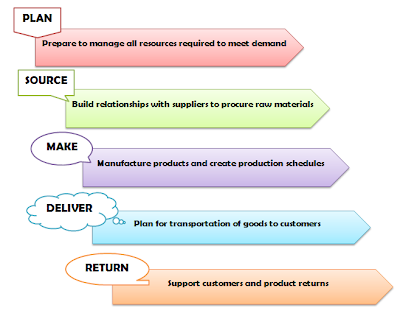BASICS OF SUPPLY CHAIN
SCM – the management of information flows between and among stages in a supply chain to maximize total supply chain effectiveness and profitability
The supply chain has three main links.
1. Materials flows from suppliers and their upstream suppliers at all levels
2. Transformation of materials into semi-finished products, or the organization’s own production processes
3. Distribution of products to customers and their downstream customers at all levels
INFORMATION TECHNOLOGY’S ROLE IN THE SUPPLY CHAIN
Information technology’s primary role in SCM is creating the integrations or tight process and information linkages between functions within a firm such as marketing, sales, finance, manufacturing, and distribution – and between firms, which allow the smooth, synchronized flow of both information and product between customers, suppliers and transportation providers across the supply chain
VISIBILITY
· Supply Chain Visibility is the ability to view all areas up and down the supply chain. Changing supply chains requires a comprehensive strategy buoyed by information technology. Organizations can use technology tools that help them integrate upstream and downstream, with both customers and suppliers.
· The bullwhip effect occurs when distorted product demand information passes from one entity to the next throughout the supply chain.
CUSTOMER BEHAVIOR
· The behavior of customers has changed the way businesses complete. Customers will leave if a company does not continually meet their expectations. They are more demanding because they have information readily available, they know exactly what they want, and they know when and how they want it.
· Demand planning software generates demand forecasts using statistical tools and forecasting techniques. Companies can respond faster and more effectively to consumer demands through supply chain enhancements such as demand planning software.
· Once an organization understands customer demand and its effect on the supply chain it can begin to estimate the impact that its supply chain will have on its customers and ultimately the organization’s performance.
COMPETITION
· Supply chain planning (SCP) software uses advanced mathematical algorithms to improve the flow and efficiency of the supply chain while reducing inventory. SCP depends entirely on information for its accuracy.
· Supply chain execution (SCE) software automates the different steps and stages of the supply chain. This could be as simple as electronically routing orders from a manufacturer to a supplier.
SPEED
· These systems raise the accuracy, frequency and speed of communication between suppliers and customers, as well as between internal users.
· Another aspect of speed is the company’s ability to satisfy continually changing customer requirements efficiently, accurately and quickly.
SUPPLY CHAIN MANAGEMENT SUCCESS FACTORS
· To succeed in today’s competitive markets, companies must align their supply chain with the demands of the markets they serve.
· Supply chain performance is now a distinct competitive advantage for companies proficient in the SCM area.
MAKE THE SALE TO SUPPLIERS
The hardest part of any SCM system is its complexity because a large part of the system extends beyond the company’s walls. Not only will the people in the organization need to change the way they work, but also the people from each supplier that is added to the network must change. Be sure suppliers are on board with the benefits that the SCM system will provide.
WEAN EMPLOYEES OFF TRADITIONAL BUSINESS PRACTICES
Operations people typically deal with phone calls, faxes and orders scrawled on paper and will most likely want to keep it that way. Unfortunately, an organization cannot disconnect the telephones and fax machines just because it is implementing a supply chain management system. If the organization cannot convince people that using the software will be worth their time, they will easily find ways to work around it, which will quickly decrease the changes of success for the SCM system.
ENSURE THE SCM SYSTEM SUPPORTS THE ORGANIZATION GOALS
It is important to select SCM software that gives organizations an advantage in the areas most crucial to their business success. If the organizational goals support highly efficient strategies, be sure the supply chain design has the same goals.
DEPLOY IN INCREMENTAL PHASE AND MEASURE AND COMMUNICATE SUCCESS
Design the development of the SCM system in incremental phases. For instance, instead of installing a complete supply chain management system across the company and all suppliers at once, start by getting it working with a few key suppliers, and then move on to the other suppliers. Along the way, make sure each step is adding value through improvements in the supply chain’s performance. While a big-picture perspective is vital to SCM success, the incremental approach means the SCM system should be implemented in digestible bites and also measured for success one step at a time.
BE FUTURE ORIENTED
The supply chain design must anticipate the future state of the business. Because the SCM system likely will last for many more years than originally planned, managers need to explore how flexible the systems will be when (not if) changes are required in the future. The key is to be certain that the software will meet future needs, not only current needs.


















.jpg)












